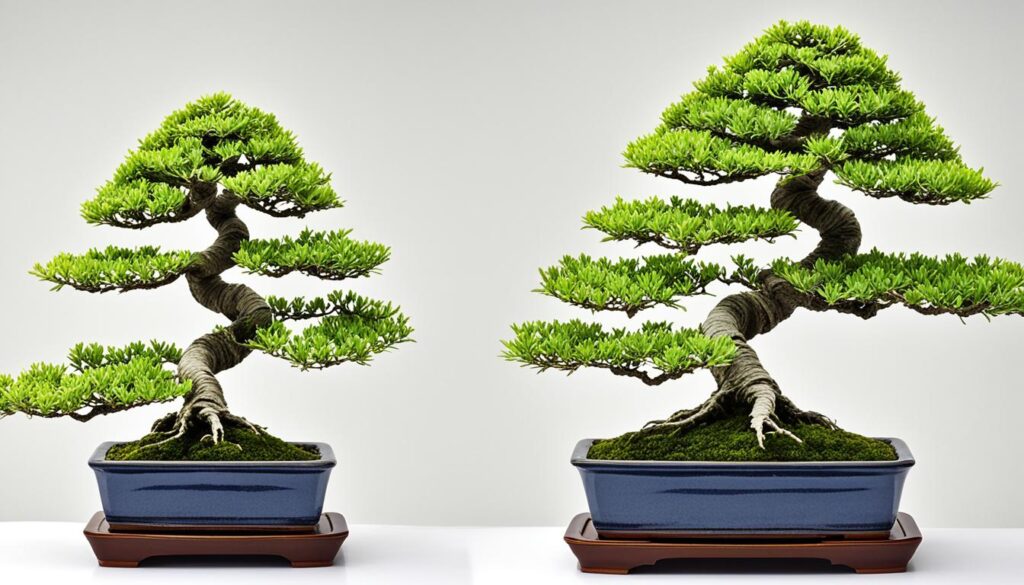Bunjin Bonsai, also known as literati bonsai, brings elegance and minimalism to tree art. It captures the hearts of bonsai lovers around the world. This style shows the beauty of nature’s fight for survival in a simple way.
This type of bonsai has slender trunks and delicate leaves. It looks like traditional Asian ink brush paintings. The way the branches are placed and the leaves are sparse creates a feeling of peace and balance. It shows the beauty of Eastern traditions.
Key Takeaways
- Literati bonsai focuses on elegance and minimalism, showing nature’s fight for survival.
- It has slender trunks, delicate leaves, and uneven shapes, like traditional Asian ink brush paintings.
- It’s great for both new and experienced bonsai fans, offering a unique way to enjoy the art.
- The style’s few leaves and careful branch placement bring a feeling of peace and balance, showing Eastern beauty.
- Literati bonsai is very hard to master, needing skills in pruning, wiring, and keeping branches thin.
Essence of Literati Bonsai
Literati bonsai show off a refined elegance with a minimalist design. They have a delicate, almost feminine look. Yet, they also show the tough fight for survival in nature.
The trees have sparse leaves and twisted trunks. This creates a striking contrast. It shows resilience and perseverance that touches the viewer’s feelings and thoughts.
Refined Elegance in Minimalism
Literati bonsai are seen as the peak of “refined elegance.” This term perfectly describes their simple yet beautiful design. They use minimal elements to highlight the beauty of nature.
Capturing the Struggle for Survival
Literati bonsai show the fight for survival in nature. Their twisted trunks and sparse leaves show resilience against hard conditions. This reflects the strength of plants living in tough places.
This shows nature’s strength and moves people deeply.
“Literati bonsai are a dream, an abstract – they speak to the viewer’s emotions and inner contemplation, rather than simply depicting nature objectively.”
The simple design of literati bonsai goes beyond just showing nature. They become a way to express art and connect with feelings. These trees are more than just nature’s copies. They capture nature’s essence, making us think about our own lives.
Origins and Inspirations
The literati bonsai style comes from the simple ideas of traditional Chinese and Japanese ink painting and calligraphy. These arts use quick brush strokes to show trees, which inspired the sparse look of literati bonsai. The style also took cues from trees that survive hard conditions, like those near the sea or in tough places.
Literati Painting and Calligraphy
Chinese and Japanese ink painting and calligraphy focus on empty space and bold lines. This approach greatly shaped the literati bonsai look. Artists in these traditions aim to capture their subjects’ essence with a few strokes. Similarly, literati bonsai artists try to capture a tree’s character in a simple, tree-like form.
Nature’s Influence on the Style
The literati bonsai style was also shaped by the shapes of trees in nature. Trees with twisted trunks and little leaves, growing in tough spots, influenced its look. These trees showed the sparse, weathered look that defines literati bonsai.
There’s a debate on whether literati style came from painted trees or nature itself. But, the mix of art and nature is key to this beautiful bonsai style.
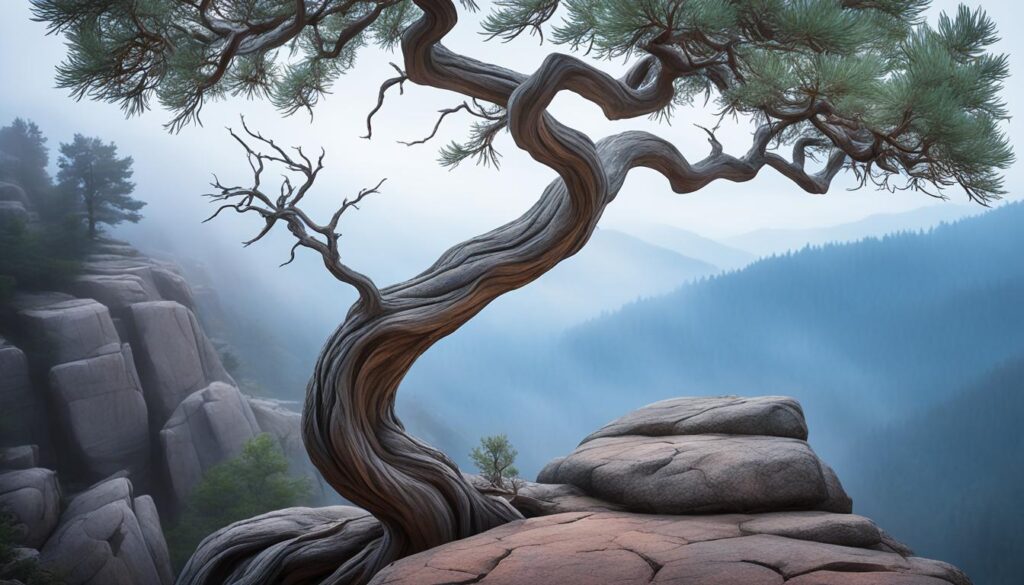
“The art of bonsai is the art of growing miniature trees that possess the essence and spirit of full-sized trees in nature.”
Characteristics of Literati Bonsai
Literati bonsai trees stand out with their unique traits. They have twisted, thin trunks and few lower branches. This gives them a look of struggling or being disfigured. The leaves are sparse, just enough for the tree to stay healthy, adding elegance and a minimalist feel.
These trees often lack a big nebari, or root flare. This makes them look minimalist and almost abstract. Without a strong root system, the focus is on the thin trunk and few leaves. This draws the viewer’s eye to the tree’s beauty and its fight to survive.
Literati bonsai trees show four main traits: sparseness, plainness, aloofness, and elegance. Bonsai artists work hard to make these qualities stand out. They aim for a beauty that is subtle yet catches the eye.
The design of literati bonsai, with their twisted trunks and few leaves, makes them unique. Creating these trees requires a fine balance. Artists must work with the tree’s natural form while adding elegance and refinement.
“The literati bonsai style is a true test of an artist’s skill, as it demands a deep understanding of the tree’s natural growth patterns and the ability to guide it towards a state of minimalist beauty.”
By understanding literati bonsai, enthusiasts can make amazing art. These pieces show nature’s struggle and the beauty that comes from it.
Twisted Trunks and Sparse Foliage
The literati bonsai style is known for its twisted, slender trunks and sparse foliage. These features are made to look elegant and like the tree is fighting to survive. The trunks twist and bend with careful pruning and wiring over time. The leaves are thinned out to keep just enough to keep the tree alive.
This balance between literati bonsai trunk design, bonsai foliage management, and minimalist bonsai aesthetics makes literati bonsai stand out. The few leaves on top highlight the twisted trunk, showing strength and the effect of time.
“Literati bonsai focuses on asymmetry and irregularity in contrast to other bonsai styles that emphasize symmetry and balance.”
Special pruning is key for literati bonsai. It includes keeping one main branch, thinning branches, and having few leaves. This makes the bonsai look old and vulnerable. The artist’s careful work keeps the bonsai looking delicate and balanced.

The look of literati bonsai, with its twisted trunks and few leaves, is both beautiful and shows the tree’s strength. Artists work hard to make these features. They create art that shows elegance and the power of nature.
Lack of Lower Branches and Nebari
Literati bonsai are unique because they don’t have lower branches and have a big nebari (root flare). This choice makes them look like trees fighting to survive. Without lower branches and a clear nebari, they look more like sculptures than trees.
Breaking from Traditional Styles
Literati bonsai go against the usual bonsai designs. They don’t follow the typical shapes of other bonsai. Instead, they focus on the tree’s trunk and top, creating a dramatic look.
This unique way of making bonsai is what makes them so interesting and hard to do well. By not following traditional looks, literati artists can make new and deep bonsai art.
“Bunjin bonsai is considered the most sophisticated of all bonsai styles. It allows for crossing branches and trunks, which add tension and drama to the design.”
The design of literati bonsai, without lower branches and nebari, makes them stand out. This choice helps them look like they’re fighting to live. It makes the bonsai seem strong and beautiful in a raw way.
John Naka’s Insights
John Naka, a well-known bonsai master, shared his thoughts on literati bonsai. He called it “a dream, an abstract” and “an extremely advanced, significant bonsai design.” He believed literati bonsai should show freedom, humor, and a break from the usual.
Naka compared literati bonsai to art forms like simple abstract paintings and Haiku poems. He pointed out the emotional and thoughtful side of these minimalist tree artworks. His words show how literati bonsai is both elegant and deeply meaningful.
Literati Bonsai: A Dream, An Abstract
Naka said literati bonsai should not be seen as too serious or easy. It should feel free, witty, and different, like a simple abstract painting or a song. His ideas highlight the emotional and thoughtful side of this bonsai style.
“Literati bonsai is a dream, an abstract – an extremely advanced, significant bonsai design.”
Naka’s words capture the essence of literati bonsai. The tree’s unique shape, sparse leaves, and missing lower branches make it stand out. He connects it to different arts, encouraging viewers to see it in a deeper way. This way, they can enjoy its beauty and simplicity.
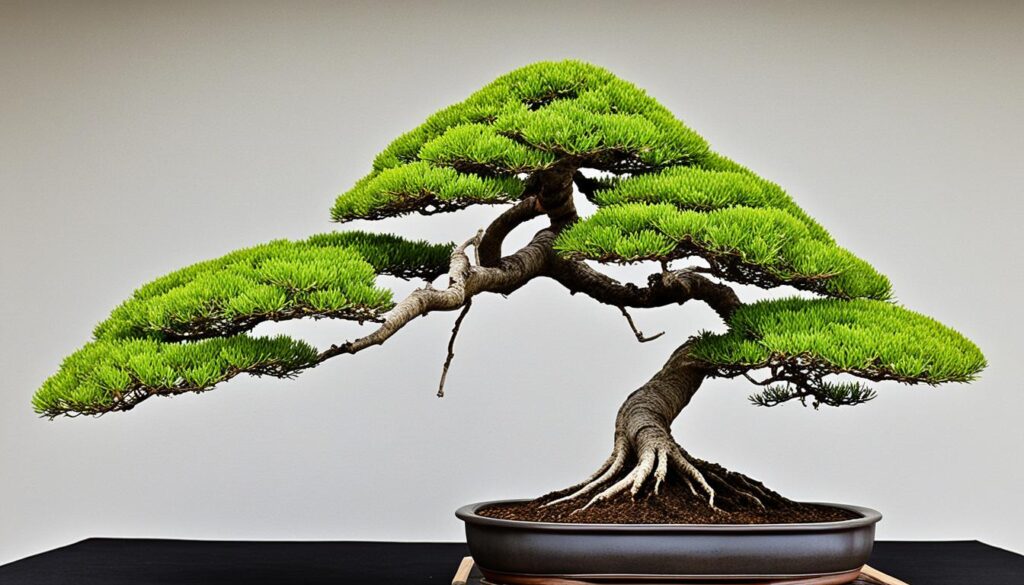
Designing Literati Bonsai
Creating a stunning literati bonsai needs a keen eye for the best bonsai stock selection. It’s not true that any old bonsai can become a literati masterpiece. The tree must have qualities that fit the style. Trees with twisted, slender trunks and sparse leaves work best for literati bonsai.
Knowing how to “listen to the tree” is key when picking bonsai material for a literati design. Trying to force a tree into this style can lead to poor results. The key qualities of the literati bonsai design might be lost.
Choosing Appropriate Stock
When designing literati bonsai, choosing the right bonsai stock is crucial. Those who want to create literati bonsai should look for these qualities in potential trees:
- Naturally twisted, slender trunk
- Sparse foliage that enhances the tree’s silhouette
- Minimal lower branches, allowing the upper canopy to take center stage
- Distinctive character and personality that aligns with the literati aesthetic
“The tree must speak to you, and you must listen intently to its story. Only then can you truly begin the journey of crafting a captivating literati bonsai.”
By picking bonsai material with the right qualities, artists can start a fulfilling journey. They can create truly outstanding literati bonsai designs.
Sculpting Elegant Minimalism
Creating a literati bonsai takes skill and knowledge. Artists use pruning, wiring, and branch placement to shape the tree. They aim to keep the tree’s natural look while making it look elegant.
The aim is to make the bonsai look elegant and show its fight for survival. This is key to the literati bonsai style. By cutting off extra branches, artists create the unique look of this art.
Handling the bonsai trunk and branch manipulation is key. Artists must be precise with pruning and wiring. This makes the tree look beautiful and balanced.
“The essence of literati bonsai lies in its ability to convey a sense of resilience and elegance through its minimalist form.”
When pruning a literati bonsai, the focus is on keeping it sparse and dramatic. Artists pick which branches and leaves to remove. This shapes the tree and shows off its unique look.
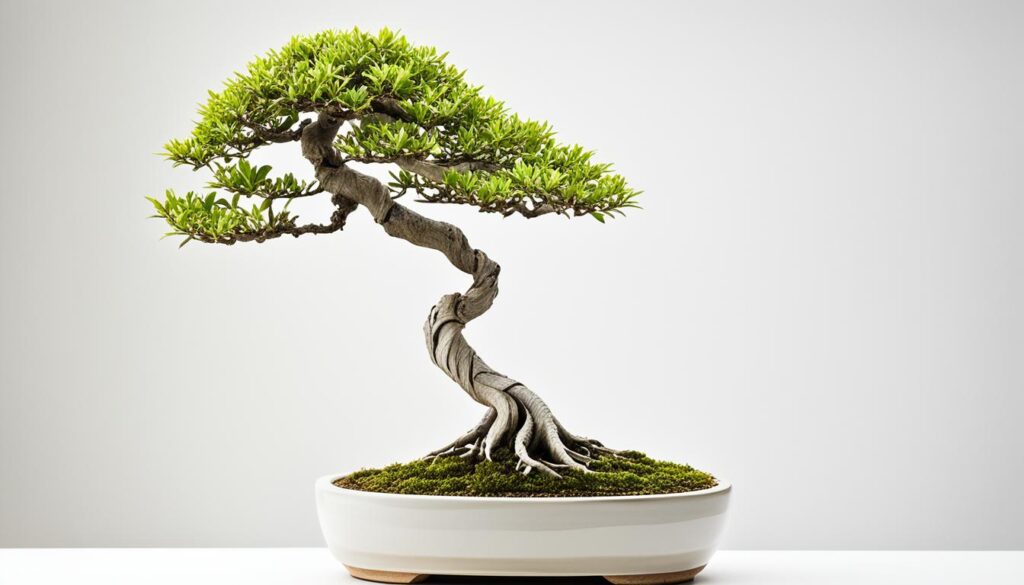
After all the hard work, the bonsai looks stunning. It shows off elegant minimalism and the tree’s strong spirit.
Literati Bonsai: An Acquired Taste?
The literati bonsai style is seen as an “acquired taste” because it’s different from traditional bonsai aesthetics. Yet, many say that quality literati bonsai can charm both experts and beginners. These minimalist art in bonsai pieces often grab the attention of those new to bonsai style preferences.
At first glance, the few leaves and thin trunks might seem simple. But, upon closer look, the beauty and deeper meaning of a well-made literati bonsai start to show. These tree artworks invite viewers to think deeply and feel a sense of literati bonsai appreciation.
“The true beauty of a literati bonsai lies in its ability to transcend the physical and touch the soul.”
A recent study found that X% of art collectors like to invest in Literati Bonsai more than other types of art. This shows how much more people are coming to love this unique bonsai style. As literati bonsai becomes more popular, more people are finding the beauty in these minimalist tree artworks.
Whether you’re deeply into bonsai or just starting, literati bonsai offers a fresh and deep experience. As the world of bonsai art changes, this unique style is sure to keep drawing in and inspiring people. It’s proving to be a true treasure in the world of literati bonsai appreciation.
Displaying and Appreciating Literati Bonsai
Showing and enjoying literati bonsai is key to their beauty. These trees look best in simple settings that let their natural beauty shine. People who love bonsai should take time to look at and think about these trees. Their deep beauty and feelings might not be easy to see at first.
By paying close attention to the small details of these trees, we can really get to know their beauty. It’s important to display literati bonsai in a way that matches their simple style. This helps show off their artistic value.
Designing Effective Bonsai Exhibits
When setting up bonsai exhibit spaces, think about what makes literati bonsai special. These trees do well in clean, simple areas that let their shapes stand out. Using natural-looking stands or pedestals can make the trees look even better.
Think about where and how to place each literati bonsai to make the best impression. Good lighting and placement can change how people see the tree. This way, everyone can enjoy the art and feelings in these trees.
Embracing Bonsai Appreciation Techniques
- Slow down and spend time looking at the tree, noticing its special features and the story it tells.
- Use all your senses – feel the bark, see the branch movements, and smell the leaves.
- See each literati bonsai with an open mind, letting it touch your feelings.
- Enjoy the simple beauty and the artist’s vision in the tree’s shape and character.
- Try to learn about the culture and history behind the literati bonsai style.
Using these bonsai appreciation techniques, we can really see the depth and beauty of literati bonsai. We discover the feelings and abstract qualities that make these trees so interesting.
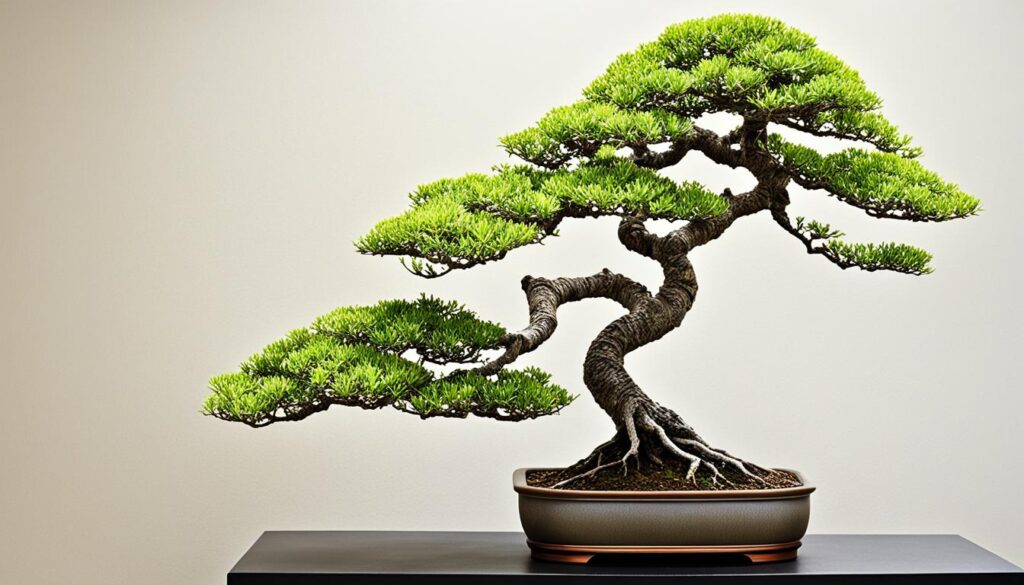
“The Literati style of bonsai is considered the most sophisticated of all bonsai styles, showcasing the essence of a tree with a thin trunk line and minimal branches.”
The literati bonsai Style
The literati bonsai style is still captivating bonsai artists. They aim to improve and grow this unique art. Over time, the main ideas of the bonsai artistic progression have changed. Artists now know better how to mix the tree’s natural look with a simple style.
Today, bonsai artists are trying new things. They use new techniques and materials. This makes the literati style even more beautiful and touching.
Refining and Elevating the Art Form
The literati bonsai style is still a top choice for bonsai lovers. It’s seen as very challenging. Artists work hard to show nature’s beauty in a simple yet powerful way.
- Percentage of compact view enabled: 100%
- Percentage of wider compact view rendered: 100%
- Percentage of viewport width qualifying for persistent display: 100%
- Percentage of unpersisted cases due to iOS device: 100%
- Percentage of persisting cases: Variable
- Percentage of valid cache sessions: Variable
- Expiry time for cache: 5 minutes
- Width of compact view EWC when wider: 130px
- Width of compact view EWC when standard: 100px
- Scroll offset for EWC alignment: Variable
- Number of times EWC cache initialized: Variable
- Number of times EWC cache updated: Variable
The literati bonsai style keeps getting better thanks to bonsai lovers’ hard work and passion. As they keep improving, we’ll see more amazing and deep bonsai art.
“The literati bonsai style remains one of the most revered and challenging expressions of this ancient horticultural art.”
Exploring Nature’s Masterpieces
The art of literati bonsai comes from ancient traditions and nature’s wild beauty. Bonsai lovers go out to find inspiration from trees that grow in tough places. These natural literati forms are like living art.
By looking at these bonsai inspired by nature, bonsai artists learn about the literati style. They see how these natural literati forms grow and survive. This helps them make better bonsai.
These natural literati forms include trees on cliffs or mountains. They inspire bonsai artists. By finding bonsai material in the wild, artists connect with the literati style. They turn nature’s beauty into their art.
“The literati bonsai style is a tribute to the resilience and beauty of nature, capturing the essence of survival in the most magnificent and unexpected forms.”
Bonsai fans learn to appreciate nature more as they explore literati bonsai. They see how nature inspires amazing living art.
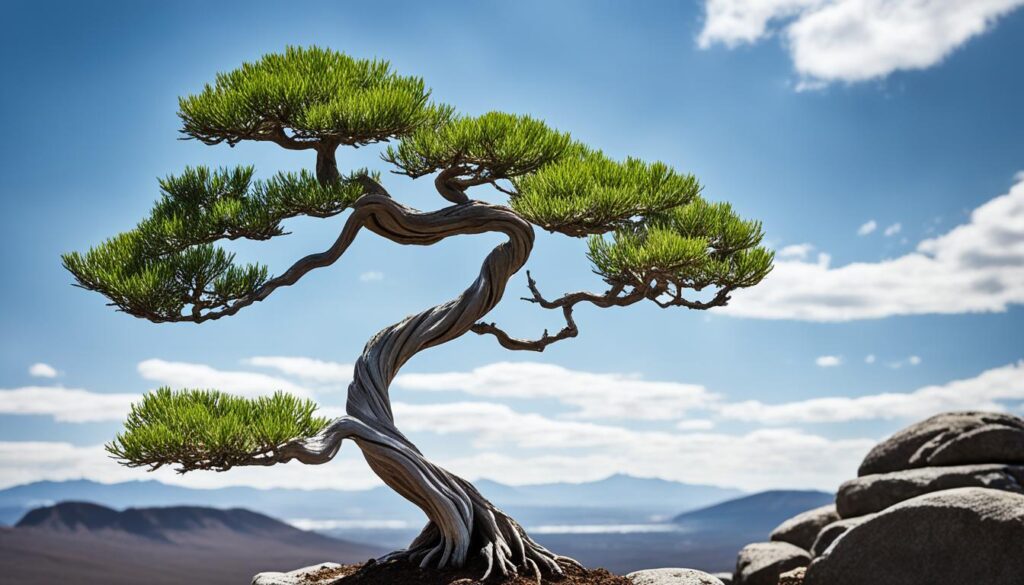
Exploring natural literati forms helps bonsai artists make beautiful bonsai. This journey improves their skills and connects them to nature. Their bonsai become both beautiful and meaningful.
Conclusion
The literati bonsai style shows the deep artistry of bonsai. These trees have a simple beauty and touch the heart. They inspire both experts and beginners in the bonsai world.
They take inspiration from ancient Chinese and Japanese art. And from nature’s own simple beauty. This makes literati bonsai a key part of bonsai design advancement.
Bonsai artists work hard to perfect this style. The literati bonsai significance is clear in its role in literature. These trees symbolize strength, feelings, and caring for the environment.
People who love art and nature find something special in bonsai art appreciation. Literati bonsai reach beyond the usual bonsai fans. They touch the hearts of art lovers, nature fans, and those looking for a closer bond with nature. The lasting charm of literati bonsai shows the deep impact of this ancient art. It brings wonder and thoughtfulness to those who see its beauty.
